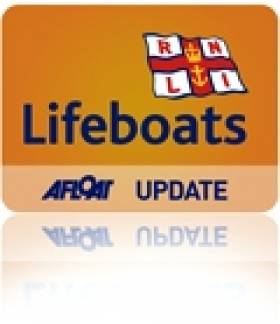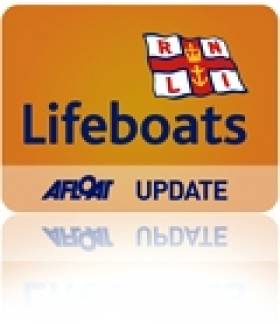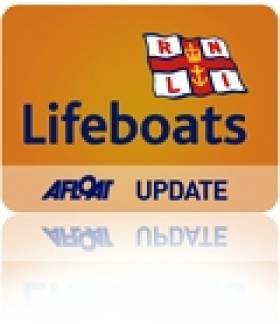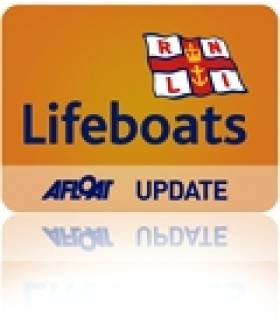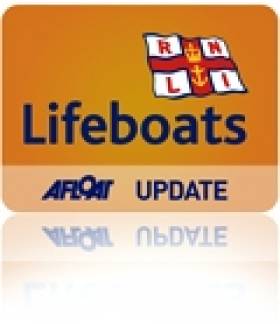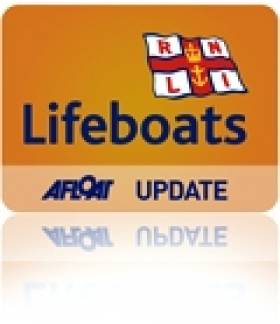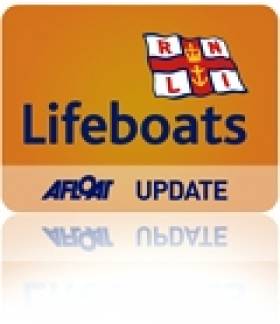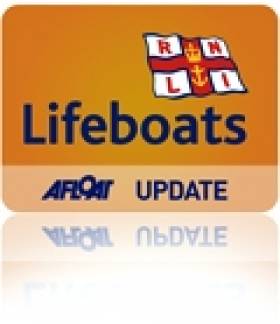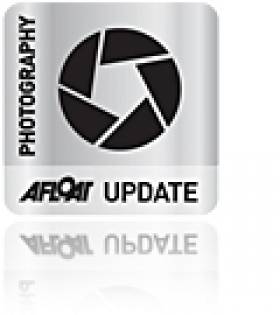Displaying items by tag: Lifeboats
Baltimore Lifeboat Rescue To Feature In RNLI Great War Exhibition
#RNLI - The role of Baltimore in the rescue of 23 people from the steamship Alondra, wrecked off the West Cork village in late 1916, is to be featured in a touring RNLI exhibition commemorating the centenary of the First World War.
Hope in the Great War, funded by Arts Council England, will honour the courage and bravery of the lifeboat crew who risked their lives to save others during WWI.
While many will be familiar with the sinking of the Lusitania off the Cork coast in 1915, fewer will be aware of this rescue, which took place in Baltimore a year later.
A decision by the RNLI charity to establish a lifeboat station at Baltimore was made in 1913 but its actual opening took place in 1919, having been delayed by the war.
It was on the 29 December 1916 that the SS Alondra was wrecked on the Kedge Rock, off Baltimore. Sixteen of her crew left in one of the ship’s boats, but drowned before reaching the shore.
The Venerable Archeacon John Richard Hedge Becher - honorary secretary of Baltimore RNLI - and some volunteers launched a boat but it failed to reach the vessel. They returned to Baltimore but put off again as some of the ship’s crew had made the rock. Failing to reach the wreck, they put back to shore again.
At daylight they set out with rocket apparatus. About the same time, two Royal Navy trawlers came upon the scene and the efforts of all, saved 23 survivors some of whom were lowered down a 150-foot cliff.
RNLI Silver Medals for Gallantry were awarded to Archdeacon Becher and Lieutenant Sanderson for their role in helping to rescue the 23 men from Alondra.
Baltimore’s lifesaving story has been chosen to feature alongside five other RNLI lifeboat services that took place in communities across Ireland and the UK.
Opening in February 2014 at the Henry Blogg Museum in Norfolk, Hope in the Great War will start a four-year tour around RNLI museums, lifeboat stations and other museums.
Now the RNLI is asking the local community in Baltimore to get in contact if they know of any details such as family memories, photographs, letters or artefacts connected to the rescue. The most relevant items may be selected to feature within the exhibition allowing the fullest story of the rescue to be told nationally.
RNLI heritage project co-ordinator Becky Fletcher said: “The outstanding efforts by Baltimore’s RNLI volunteers to save lives in WW1 will now be given a voice. “Although little details are known about the SS Alondra rescue, finding any connections would undoubtedly be of further inspiration.”
To pass on any family memories, anecdotes, photos or letters, please email [email protected] or call the RNLI Henry Blogg Museum on 01263 511294.
Locally, meanwhile, Baltimore RNLI is teaming up with members of the Baltimore Amateur Drama Group to create a piece of artwork for the tour. The group is creating a short film about the rescue which will feature within the exhibition.
Olan Marten, spokesperson for the drama group, said: “With so many members of the RNLI supporting our productions over the years, as either cast members, crew or audience it is a great honour to do something for them and also to honour the brave men involved in the Alondra rescue.
“It’s an unusual production as the crew and the director will meet for the first time on the first day of filming. Not only that but the film will travel all over Ireland and the UK for four years introducing these local amateur actors to a huge audience.”
Baltimore RNLI will be the second Cork lifeboat station to mark the role it played during the First World War.
The Courtmacsherry RNLI Lusitania Centenary Committee has already appealed to the public for artefacts, stories and memorabilia to be part of a major exhibition to commemorate the centenary of the sinking of the Lusitania off the Cork coast in 1915.
They are also calling on any family members of those lost or saved in the Lusitania tragedy to contact them to share their stories, which will then be compiled and included in the exhibition.
The commemoration will be held on the May Bank holiday weekend in 2015, with the centrepiece being a Lusitania Exhibition in Courtmacsherry RNLI Lifeboat Station and other local venues.
Courtmacsherry lifeboat responded to the tragedy in 1915 - and to coincide with the exhibition, the lifeboat crew will re-enact the call to service and row out to the site of the disaster.
Youghal RNLI Marks 175 Years With 2014 Calendar
#RNLI - Youghal RNLI is to launch a 2014 calendar to mark the 175th anniversary of the establishment of the lifeboat station, which has been serving the areas around East Cork and West Waterford since 1839.
A photographic trawl from past to present, combined with a scattering of insightful facts, makes this calendar a fascinating study of the station’s rich history.
The calendar takes us from humble beginnings when the first lifeboat station was built at a cost of £100 back in 1857, right up to the present day where we see the current state-of-the-art station that’s home to an Atlantic 75 inshore lifeboat and continues to be crewed by the community’s volunteers.
Since the station was established, Youghal RNLI has launched 504 times, saving the lives of 213 people and rescuing a further 362.
Published by Youghal RNLI and their fundraising branch, the calendar will be launched at 7.30pm on Sunday 20 October at the Mall Arts Centre in Youghal.
Speaking ahead of the launch, Youghal RNLI volunteer lifeboat press officer Noreen Varney said: “The original idea for the calendar came about following a discussion between crew members Joe Moore, Brendan O’ Driscoll, myself and fundraising secretary Susan Mason. We thought it would be a great idea given that we would be celebrating our 175th anniversary in 2014.
“Once we had decided to go for it, we asked our local businesses to sponsor the project and we are indebted to them for their support."
Varney added that the photos included “are a combination of the lifeboats we have had in Youghal throughout the 175 years and the crews that have served them. The photos were taken by various people and we are grateful to them too for their input.
“We hope the calendar will make way for a nostalgic 2014 as readers peruse the photos and savour the short snippets of history month after month. The proceeds raised from the sales of the calendar will help us to continue to save lives at sea."
The calendar - simply entitled Youghal Lifeboat Calendar 2014, will be available to purchase locally in Read & Write, Cree’s card shop, Muckley’s Jewlellers, Crowley’s service station, Galvin’s CostCutters, Country Stores Kinsalebeg, Centra in the Strand, Centra in Killeagh, J Coleman in Killeagh and the Youghal Lifeboat Souvenir shop for €10, or alternatively by contacting Noreen at 087 050 6640 or [email protected].
Fisherman Rescued By RNLI Crew Meets His Rescuers - And Owes His Life To Lifejacket Initiative
#RNLI - A fisherman whose boat sank in minutes has thanked several organisations who implemented and trained him on using a lifejacket for saving his life.
Samuel Cully, a fisherman from Portavogie, was in the water for 45 minutes after his vessel sank on Wednesday 18 September, off the coast of Co Down. Weather conditions at the time were rough seas with Force 5 to 6 winds blowing.
RNLI lifeboats from Portaferry and Donaghadee were launched within minutes of a May Day being received by the Belfast Coastguard, along with the Irish Coast Guard helicopter Rescue 116.
Recently Cully was reunited with the volunteer crew at Portaferry who rescued him.
Just weeks earlier, Cully had been provided with a personal flotation device in a grant-aided scheme run by the Fishermen’s Mission with funding and support from Seafish, the Department for Agriculture and Rural Development through the European Fisheries Fund, the Northern Ireland Fish Producers Organisation, RNLI, the Maritime Coastguard Agency and supermarket Asda.
The project aims to ensure that fishermen will receive a grant-aided PFD and the training required to ensure its proper use.
Frankie Horn, RNLI fishing safety manager for the UK and Ireland, said: "It’s great that Samuel is safe, and back with his family. We want fishermen to see the benefits of wearing a personal flotation device or lifejacket and for them to wear it voluntarily.
"This will be an ongoing process for us, talking to fishermen and working with the manufacturers to ensure that the PFDs provided are the best possible design for the fishing industry."
With the funding and logistics generously covered by other agencies, the RNLI was involved in leading the safety training session – an act that Cully is immensely grateful for.
"I was only able to swim five or ten metres or so, and even then the wind and swell were washing me away from the shore," he recalled. "The boat went down so quickly, and I was so relieved to find the lifejacket doing exactly what I was told it would do. I cannot thank all those organisations involved enough."
In more recent news, Donaghadee and Portaferry RNLI launched yesterday (Tuesday 8 October) to go to the aid of a man fishing off rocks who became stranded by the tide.
Belfast Coastguard had received a call from a member of the general public just after 10.20am alerting them of the emergency.
On arriving on the scene, Donaghadee's all-weather lifeboat crew found their colleagues from Portaferry RNLI's inshore lifeboat were taking the man off the rocks and returning him safely into Portavogie harbour.
Dun Laoghaire Lifeboat Rescues Three After Trawler Blaze
#RNLI - Three crew on a disabled fishing trawler were brought to safety by Dun Laoghaire RNLI today (Friday 4 October) after a fire broke out on board the 50-foot vessel.
The incident occurred off Bray Head at 10.30am when the Irish Coast Guard service at Dublin requested the launch of the all-weather lifeboat, which arrived on scene less than 30 minutes later.
The crew on the trawler were able to extinguish the fire but had no power to return to shore.
The lifeboat took the vessel under tow back to Dun Laoghaire in a two-hour operation. Nobody was injured in the incident.
Lough Swilly Lifeboat Launches Three Times In Busy Rescue Week
#RNLI - Lough Swilly RNLI in Co Donegal launched its lifeboats three times in the last week to three separate incidents.
The first was on Tuesday last (24 September) when the station’s volunteer crew was requested to launch its inshore Atlantic 85 lifeboat in the afternoon to assist a leisure craft that had caught its propeller on a mooring line in Leanan Bay.
On Saturday (28 September), the Atlantic 85 responded to go to the aid of a pleasure craft with mechanical difficulties from Portsalon to Fahan Marina, a distance of eight miles.
At the same time on Saturday, the station’s all-weather Tyne class lifeboat was tasked following a report from a member of the public that a number of kayakers were thought to be far off shore from Malin Head.
The lifeboat was subsequently stood down before reaching the scene as the RV Celtic Explorer - which was in the vicinity - checked with the kayakers, who reported that they were in no danger and on route to Inistrahull Island.
Speaking following the busy week, Lough Swilly RNLI deputy launching authority Eunan McConnell said: "Last week’s spell of good weather saw an increase in water-based activity in the area as people enjoyed the last rays of the summer sun.
"Whilst the station’s lifeboats were tasked to several incidents during the week, thankfully all ended well and everyone was brought home safely."
Wicklow Lifeboat Launches After Report From Concerned Boater
#RNLI - Wicklow RNLI launched its all-weather lifeboat on Monday evening (23 September) at the request of the Irish Coast Guard following a report of a fishing RIB at sea in darkness.
The alarm was raised at 8.35pm when a member of the public contacted the coastguard after passing a small rigid inflatable boat with two men onboard who were fishing near Wicklow Head. Darkness had fallen and the member of the public was concerned for their safety.
The volunteer lifeboat crew conducted a search of the bay, an illumination flare was fired to light up the search area and night vision equipment was also used.
The crew located the small RIB near Wicklow Head using searchlights at 8.48pm but the two men on board said they did not require assistance, and the all-weather lifeboat was stood down shortly before 9pm.
The lifeboat crew on the call-out were coxswain Nick Keogh, mechanic Brendan Copeland and crew members Tom McAulay, Sean Doyle, Dean Mulvihill, Graham Fitzgerald and John Vize.
Open Day At Baltimore Lifeboat Station This Weekend
#RNLI - The crew of Baltimore Lifeboat Station are inviting the public to an open day on Sunday 29 September from 2.30pm to 5.30pm.
Visitors on the day will have an opportunity to see the redeveloped station house at Bullpoint and the co-located lifeboats operating from there.
The inshore lifeboat Atlantic 75 RIB Alice and Charles is housed inside the station house on a carriage and the Tamar class all-weather lifeboat Alan Massey lies alongside in a newly excavated berth.
Crew will be on hand to show people around the station house and the lifeboats as well as giving a first hand account of rescues at sea. Information on RNLI Sea Safety resources will also be made available.
All are welcome to the open day, which is free of charge.
Kilrush Lifeboat Assists More Drifting Boats In Shannon Estuary
#RNLI - There was another call-out for the Kilrush lifeboat to retrieve a boat broken free of its moorings on Tuesday 17 September, following Sunday's assist of a boat on the rocks at Mount Trenchard in the Shannon Estuary.
The volunteer crew of Kilrush RNLI launched quickly on Tuesday afternoon after a report that the boat was adrift off Glin in Co Limerick. Conditions on the day were very unfavourable with winds blowing south-westerly and gusting to Force 8.
The helm dropped one of the lifeboat crew at Glin Pier, where a number of locals brought him to the area where the boat was gone aground. Another crew member waded out to catch a tow line from the lifeboat, then proceeded to set up a long tow and was pulled to safer waters.
The lifeboat then made its way to Glin pier were the owner was located and the vessel was tied up securely.
But the Kilrush lifeboat wasn't finished its duties yet, as around 4.45pm the coastguard relayed a message reporting another small vessel gone aground at Hog Island, near Cappa Pier at Kilrush.
The crew quickly turned westwards toward this area where they found a sailing boat up on the rocks on the spit at Hog Island.
Again the speed of the crew proved invaluable as they transferred one of their crew onto the shore, where he quickly established a towline. The Kilrush crewman stayed on the vessel, communicating all the time with the lifeboat and the coastguard. Within five minutes the boat was tied up at Cappa Pier and safely secured.
Kilrush RNLI lifeboat press officer Pauline Dunleavy said: “It is at times like these that constant training pays off. The lifeboat crew braved the elements and brought a satisfactory outcome to the owners of these vessels.
"I would advise people to check that their mooring lines are strong and stable.”
Elsewhere, Crosshaven RNLI brought a troubled fishing boat with one person onboard to safety yesterday evening (18 September).
A mobile phone call to one of the Crosshaven RNLI crew members alerted them to a disabled fishing vessel seven miles south of Roches Point.
The pagers were activated and the volunteer crew of Kieran Coniry, Ian O'Keefe and Vincent Fleming launched to the aid of the stricken vessel at 4.45pm. With a north westerly Force Four wind and good conditions, the lifeboat made good progress and arrived a short time later.
The casualty vessel with one person on board had failed to restart its engine and was taken in tow by the lifeboat. The 37ft vessel was towed to Crosshaven Pier, arriving back at 7.30pm.
Kilrush Lifeboat Launches To Boat Broken Free of Moorings
#RNLI - Kilrush RNLI launched on Sunday 15 September shortly after 1pm following a request from Valentia Coast Guard to go to the aid of a boat which had broken its moorings off Labasheeda in Co Clare.
The volunteer lifeboat crew assembled and launched immediately, heading for the indicated area. Conditions were blowing quite hard at the time, with north westerly winds blowing.
The crew battled their way to the scene reaching the location at 2pm, whereby they set up watch and located the 6.5m vessel on the rocks at an area known as Mount Trenchard, east of Glin, near Foynes in Co Limerick.
Weather conditions were very strong and gusting Force 8, and in the interest of safety the decision was made to leave the vessel which was securely placed where it had gone aground with a view to it being removed to Foynes Harbour the following morning.
Kilrush RNLI lifeboat operations manager John Lamb said he was happy with the outcome and in view of safety of his crew that the right call was made on this occasion.
Lifeboat Photographer Captures 'Courage On Our Coasts'
#Photography - A new book and exhibition showcasing striking photos of the lifesaving work of the RNLI were launched last week.
The Lifeboat: Courage On Our Coasts showcases over 400 iconic images captured through the lens of RNLI lifeboat crew member and award-winning professional photographer Nigel Millard, from dramatic shots of lifeboats battling fierce seas to candid portraits of the charity’s dedicated volunteer crew members, lifeguards and fundraisers.
Millard’s photos – the result of two years’ work – offer a unique eyewitness insight into the full scope of the RNLI’s lifesaving work.
To capture the images, Millard, who volunteers as a crew member at Torbay in Devon, visited RNLI lifeboat stations and lifeguard units around the UK and Ireland. At each station, Nigel carried a pager and was alerted to shouts, along with the local crew, to capture the action first-hand.
Hear Millard read an exerpt from his visit with Rosslare Harbour RNLI:
A selection of striking images from the book also features in a touring exhibition of the same name - the first time that photographs of the RNLI’s work have been made available to the public in this way. The exhibition will travel to locations including London, Manchester, Edinburgh, Cardiff, Dublin and Birmingham.
Copies of the book - written by Dr Huw Lewis-Jones, with the foreword by HRH The Duke of Cambridge - will be available to buy at the exhibition, along with other specially-designed merchandise featuring Nigel’s stunning images.
Nigel Millard says he hopes the images will give people a better understanding of the RNLI’s lifesaving work.
"My favourite photo is a casualty’s eye view," he says. "I’ve been a man overboard on exercises – once in the water, you see nothing, then just a tiny bit of orange, and it’s not the sun, it’s a lifeboat. It epitomises the work I do, and the work of the RNLI.
"I hope the exhibition will raise awareness of the charity. People who don’t know anything about rescue at sea will get to hear about it, they will know we’re here to help. Someone might be inspired to volunteer – not necessarily on the crew, but maybe as a fundraiser. Or some might wish to donate."
Dr Lewis-Jones, who accompanied Nigel on many of his photo shoots, says of the book and exhibition: "It’s a show of great photos that represent the best of the RNLI. It’s a way of reminding people that they are only ever 70 miles from the sea – we may all need the RNLI’s help.
"We’ve joined crews all around the country on shouts, but also for a cup of tea. The photos are a collection of what the RNLI family means, the true spirit of the RNLI – ordinary people doing extraordinary things."
The book’s will be available 30 September direct from the RNLI (www.rnlishop.org) as well as good bookshops and stockists including Amazon.
And in partnership with Epson, the RNLI is also running a photography competition, My Coast, while the exhibition is touring.
The charity is challenging photographers to capture what the varied and beautiful coasts of the British Isles mean to them. The winner will receive a large format print of an image of their choice from The Lifeboat: Courage on our Coasts exhibition, signed by the photographer Nigel Millard; a photo quality Epson colour printer (kindly donated by Epson); and a waterproof housing for an SLR camera and an iPhone waterproof housing (kindly donated by Cameras Underwater).
A shortlist of 10 entries will be selected by Nigel Millard. He will be looking for striking images that encapsulate the photographer’s experience of the British Isles coastlines and something of their relationship with the sea. The short-list will then go forward for a public vote on the RNLI’s Facebook page.
The closing date for entries is Monday 31 March 2014 and the winner will be notified by Monday 5 May 2014. Entries should be submitted by completing the online form at www.rnli.org/mycoast and emailing images as a JPEG file to [email protected].
For those who can’t make it to the exhibition, an online version will also be available at www.rnli.org/courageonourcoasts.


























